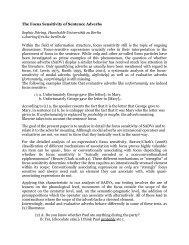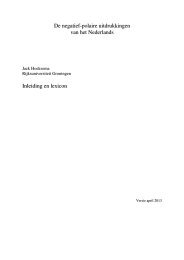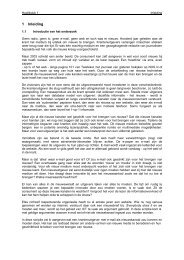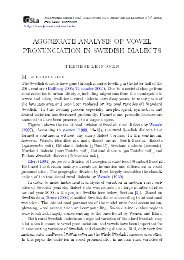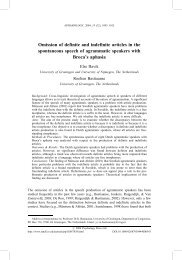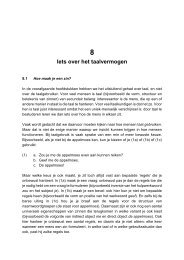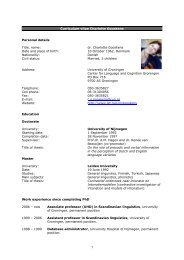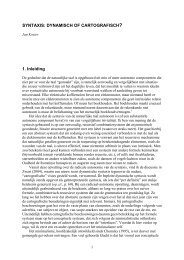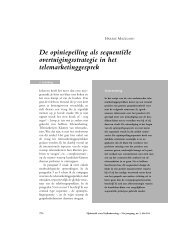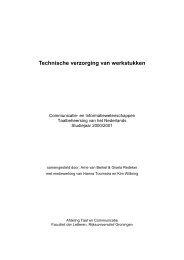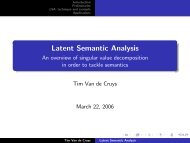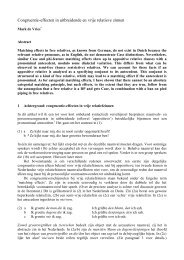Coordination. A minimalist approach. Janne Bondi Johannessen ...
Coordination. A minimalist approach. Janne Bondi Johannessen ...
Coordination. A minimalist approach. Janne Bondi Johannessen ...
You also want an ePaper? Increase the reach of your titles
YUMPU automatically turns print PDFs into web optimized ePapers that Google loves.
eanalyzed as VO languages (Zwart 1992). This clearly strengthens the typological<br />
generalizations made in J’s book.<br />
It would have been interesting to see a discussion of the word order variation in coordination,<br />
and of the variation regarding which of the conjuncts is the regular one in unbalanced<br />
coordination, in the context of Kayne’s (1993) conjecture that heads and specifiers are invariably<br />
to the left. J crucially relies on the reality of a basic OV/VO distinction in her analysis of<br />
unbalanced coordination. Thus, in an OV-language, it is the second conjunct which is in<br />
construction with the licenser outside the coordinated construction. To account for this, J<br />
assumes that the relevant languages have a specifier position to the right, occupied by the second<br />
conjunct, which then agrees with the outside head, also positioned to the right.<br />
If Kayne is right, the OV order must be derived by movement, and so must the order of the<br />
conjuncts within the coordinated construction. It is not immediately clear how this can be worked<br />
out, which makes it understandable, though regrettable, that J refrained from tackling this<br />
question.<br />
J’s laudable preoccupation with issues of phrase structure extends to the rather tricky question<br />
of how coordinate structures come into being (in a phrase structural sense). It seems to me that<br />
here J’s <strong>approach</strong> is not as compatible with the <strong>approach</strong> to phrase structure building in Chomsky<br />
(1992) as we are led to believe.<br />
First off, simple coordinations like A and B can easily be derived in the bottom-up structure<br />
building procedure of Chomsky (1992). Insertion of such a chunk in a larger structure, for<br />
instance in the complement position of a verb, is a possibility that the structure building<br />
procedure does not exclude (contrary to what J suggests on p. 129). The question that arises,<br />
however, is whether all coordination phenomena can be described in terms of this bottom-up<br />
structure building process.<br />
J argues that coordination always involves two or more CPs (see also Van Oirsouw 1987,<br />
Wilder 1994). Of the elements of these component sentences, those that match are merged, and<br />
those that do not match are coordinated (by a process called coordinate alpha). 3 Van Oirsouw<br />
and Wilder, on the other hand, assume that matching elements delete. The merging <strong>approach</strong> and<br />
the deletion <strong>approach</strong> may be viewed as two opposing trends in theorizing about coordination.<br />
In opting for merging, J essentially sides with the factorization <strong>approach</strong> of Williams (1978) and<br />
the linearization <strong>approach</strong> of Goodall (1987).<br />
It is unfortunate that the thesis does not contain an extensive discussion of the merging<br />
<strong>approach</strong> as compared with the deletion <strong>approach</strong> (see e.g. p. 113). Merging and coordinate alpha<br />
cannot but be viewed as additions to the structure building process of generalized transformation,<br />
whereas deletion merely makes use of zero copies of material elsewhere expressed.<br />
There is much more that could be said about this thesis. For example, J’s claim that<br />
extraction from coordinated constructions is constrained on grammatical rather than syntactic<br />
grounds (p. 133), does not seem to be supported by an adequate analysis of the relevant data.<br />
Since anything can be coordinated with anything in the coordinate alpha <strong>approach</strong>, there is no<br />
reason to analyze the conjunction reduction facts studied in H`hle (1983), Zwart (1991), and<br />
elsewhere as involving extraction out of the first conjunct (see p. 137). 4<br />
In all, however, the exploratory nature of much of the analysis is counterbalanced by the<br />
wealth of new material for the linguistic community to think about.<br />
Footnotes<br />
1. This is not to say that J’s analysis of the data is beyond discussion. For instance, she consistently analyzes serial<br />
verb constructions as involving coordination rather than subordination (p. 33). I also disagree with the judgment



